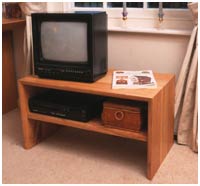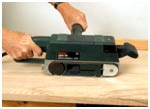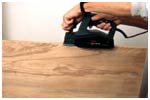
Perfect for drinks and magazines in the living
room, or as a stand for a TV and video, this clean-lined, low table isn't
hard to make, as Dave Mackenzie explains

This versatile table is made from European ash, an open-textured timber
with a straight grain and a colour ranging from pale cream to pale brown.
However, I managed to find some with a darker stain running through parts of
the grain and also with some areas of wild grain, both of which I think add
visual interest. When you're working with solid timber, it's important to
consider the natural qualities in the material and how they'll relate to the
overall design. In this case, an uncomplicated design is offset by the
inherent qualities of the timber. |
| |
|
Construction |
 |
| |
 |
I used three 8ft boards which I had planed
to size [6in (152mm) wide and 1in (25mm) thick] by my local supplier. I then
checked each one carefully to ensure that the edges were square - where
necessary, they were adjusted with a plane. Once jointed the three boards
will be just over the necessary width of 17in.
Once this initial dimensioning has been done, lay out the three planks to
work out the best arrangement, ensuring that the good faces are on the
outside. It looks good if you cut the top and sides from continuous lengths
so that the same grain pattern runs across the top and down each side. When
you've decided the positioning of each board (ensuring that each plank has
the growth rings on the end grain placed alternately up and down to avoid
warping), cut each one into four pieces (i.e. top, 2 sides, shelf) slightly
longer than required. Clearly identify which pieces are to be joined
together, then mark on the jointing edges of each the position of the centre
point of the biscuits, about 4in (100mm) apart. |
| |
|
Biscuit Joints |
 |
 |
 |
I chose to use biscuits because when cut with a biscuit
jointer they're one of the quickest and most accurate ways of edge jointing
planks. |
 |
 |
When the grooves have been cut, apply glue to the joints,
place the biscuits into the slots and clamp the planks together. |
 |
 |
The clamps are positioned alternatively under and over the
workpiece to minimize distorting the wood when pressure is applied. |
 |
 |
When the glue has dried, remove the clamps and use a large
square to mark the edges before trimming them with a saw. |
 |
 |
At this stage, remove any glue and blemishes on the faces
of the boards with a belt sander. |
| |
|
Edge Profile |
 |
 |
 |
There are a number of ways to shape the quadrant moulding
on the edges of the top and sides, but I opted to work the curved profile
using a powered plane and abrasive paper.
Mark the profile of the quadrant on the ends of the edges of each piece,
then use a plane to take off the corners as close to the line as possible.
Finally, use abrasive paper on a shaped block to complete the rounding
process.
Alternatively, make a template for the shape from a piece of thick
card hold it against the shape as work proceeds along the length of the
board until the profile is reached. |
| |
|
Mitre Joints |
 |
| |
 |
The top is mitred to the sides to create a clean
uninterrupted transition from horizontal to vertical, and are biscuit
jointed to aid location and increase the strength of the joint. Cut the
mitres with a mitre saw and use the biscuit jointer to make the grooves for
the biscuits. Note that the biscuits are not positioned in the centre of the
mitre are cut closer to the inside edge of the joint so that the cutter can
cut to the full depth for the biscuit without the risk of breaking through
to the outside surface. |
| |
 |
Take the shelf component and reduce the width by couple of
inches by sawing a piece off one edge and smoothing with a plane. Long, stub
tenons are cut at each end of the shelf and housed into mortices in the
sides. |
| |
|
Cutting List |
 |






